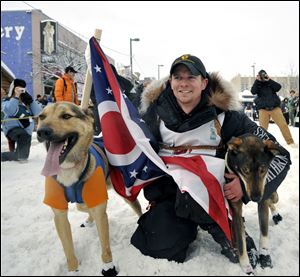
COMMENTARY
Ohio man's Iditarod
Musher calls it 'the ultimate camping trip'
3/18/2012
Matt Failor, a Mansfield native and Ohio State graduate, prepares for the start of the Iditarod while holding an Ohio flag. his father, Tim, graduated from Rossford High School, and his mother, Cheryl, graduated from Notre Dame Academy.
Nighttime temperatures of minus-40, winds off the Bering Sea cutting through you at 60 mph, treacherous ice jams, four feet of snow . . . and it's just you and your team of dogs in an Alaskan wilderness too harsh to imagine.
They don't teach you how to deal with this stuff at Ohio State.
But Matt Failor, just a few years removed from receiving his degree in fine arts and photography from OSU, has completed the Iditarod Trail Sled Dog Race -- the ultimate test of endurance, stamina, and survival. He and his team, all rookies, finished the approximately 1,200 mile course of "The Last Great Race" early Saturday morning, Alaska time.
"The challenges far exceeded what I had expected," an exhausted and relieved Failor said by phone from Nome. "I have never been mentally challenged like that before. Everything out there is messing with your mind."
Matt's parents, both natives of the Toledo area, waited in Nome as he approached the finish line.
"This is all still so very hard to comprehend," said Cheryl Failor, a Notre Dame Academy graduate. "It is just unbelievable what he is doing."
Failor had a large family contingent back here following his progress since the race started March 4.
"We're all so proud and so excited about Matt running in the Iditarod," said Laura Crumley, Matt's aunt who lives in Toledo.
"For a kid from northwest Ohio to go to Alaska and find adventure like this -- it's just an amazing story. We seem like we're a million miles away back here, but we've all been pulling for Matt to just be safe and have the experience of a lifetime."
Matt's trail to this year's Iditarod first got him acclimated with Alaska, where he worked for a number of summers while still in college. Based then in Juneau, he gave tours of the Mendenhall Glacier via dog sled.
Failor graduated from Ohio State in 2007 and spent his first winter in Alaska in 2008, working as a dog trainer and handler for Iditarod musher Matt Hayashida. Failor witnessed the finish of the Iditarod in Nome that year, which he said strengthened his bond with Alaska, the unique Alaskan sled dog and the sport of sled dog racing.
The foundation for Failor's love affair with Alaska and its seemingly boundless outdoors adventure was set in place years earlier, when he was growing up in Mansfield.
"My family taught me a love of the outdoors -- camping, fishing, canoeing, backpacking, hunting: Those were the things we did on family vacations," Failor said in an internet post before the race. "My mom and dad, and brothers and sister, all enjoy an active outdoor lifestyle."
Failor's opportunity to run in the Iditarod came about after he went to work for Martin Buser, a four-time winner of the Iditarod. Buser, a native of Switzerland who has made Alaska his home for more than 30 years, hired Failor to work at his kennels in Big Lake, about 90 miles north of Anchorage.
Failor moved to Alaska in 2010 to become part of Buser's operation, and he quickly demonstrated an ability to connect with the dogs.
Failor, who turned 30 while out on the Iditarod trail, has spent the last two years with his team of 16 dogs, raising them from pups and bonding with them each day.
"He's always loved dogs, but this is really taking that to the extreme," Failor's mother said about her son, who is an Eagle Scout, as are his three brothers.
As a race rookie with a new team, Failor used this year's Iditarod as a training run and his mother, who stayed with a number of wives of other racers while she waited for her son to reach Nome, said he approached the race that way.
"They all tell me he was doing exactly what he was supposed to be doing -- running the dogs steady and slow and not trying to win anything," she said. "He was learning the course and caring for the dogs."
Her recent time in Alaska gave Mrs. Failor a better understanding of the historical significance of the race.
"It is just an amazing thing to see. These dogs are unlike any other creatures on earth," she said.
The word Iditarod is believed to have come from the indigenous Holikachuk language and to mean "a distant place".
The Iditarod sled dog race traces its roots to the winter of 1925 when a diphtheria epidemic in Nome threatened many, especially the Alaska natives who had no immunity to the disease.
With the nearest serum in Anchorage, almost 1,200 miles away, and no other means for it to reach Nome after covering the first 300 miles by train, 20 teams of mushers and more than 100 sled dogs relayed the critical medicine the rest of the way. It took 5 1/2 days to get the serum to Nome.
The race has been run every year since 1973. More than a dozen of the 66 teams of mushers and dogs that started this year's race dropped out before completing the course.
Twenty-five-year-old Dallas Seavey, a former state champion wrestler whose father won the race in 2004, crossed the finish line on Tuesday as the winner.
Failor said nothing had prepared him for the treacherous stretch where he and his team were bouncing off frozen, charred trees in an area that had recently burned, or for the thrill of spending seven nights with the Northern Lights painting the sky.
"It was a great experience -- the ultimate camping trip, I guess you could call it."
Contact Blade Outdoors Editor Matt Markey at: mmarkey@theblade.com or 419-724-6068.